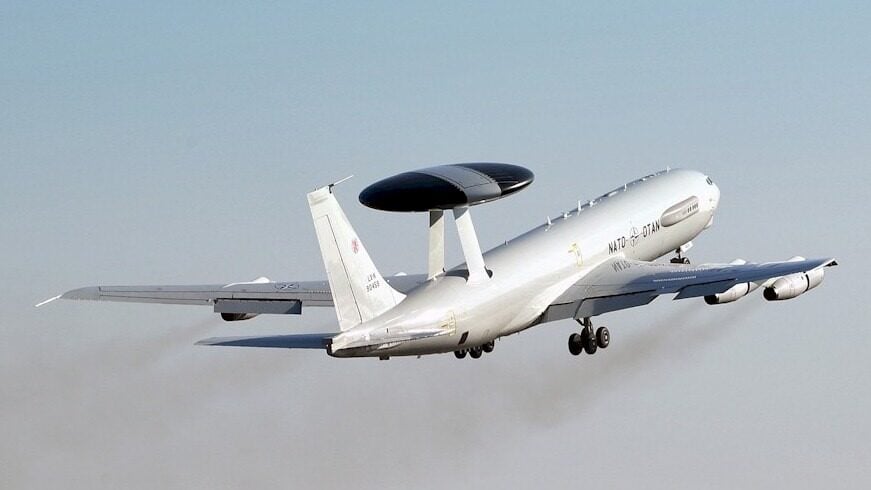
NATO E-3A Airborne Warning & Control System (AWACS) aircraft play a crucial role in supporting the alliance’s Eastern Flank presence (NATO)
Updated 2/24/23 at 1:55 pm ET to include additional comments from Saab.
BELFAST — The NATO Support and Procurement Agency (NSPA) has started assessment of industry bids for the alliance’s Allied Future Surveillance and Control (AFSC) capability program, launched to source a replacement for 14 Boeing E-3A Airborne Warning & Control System (AWACS) aircraft set to retire in 2035.
Based on an “initial” AFSC capability Request for Information (RFI) solicitation issued by NSPA in December 2022, interested competitors were asked to provide Rough Order of Magnitude price and availability of individual aircraft solutions and evidence of “existing market capabilities, potential applicable contractual frameworks, and potential benefits of a cooperative approach.”
The AFSC capability program aims to define “a new generation of surveillance and control capabilities” underpinned by a systems of systems architecture approach, intended to integrate “multiple capabilities and platforms” for future multidomain operations, according to the RFI.
“Answers to the RFI are currently being assessed,” said a NSPA spokesperson in a Feb. 22 statement.
NSPA also told Breaking Defense that as lead agency for conducting studies and developing technical concepts for AFSC, the system of systems approach covers “potential combinations” of air, ground, maritime and space assets working collaboratively to collect and share information.
The agency spokesperson said that “named invitees and respondents” who had engaged with the RFI had not been made public, but “some companies chose to announce their involvement.”
That includes Swedish manufacturer Saab, which announced it has responded to the RFI, pitching the GlobalEye Airborne Early Warning & Control (AEW&C) aircraft. Currently under order from both Sweden and the UAE, the spy plane is a modified version of the Bombardier Global 6000 business jet series integrated with Saab’s distinctive Erieye long-range radar and other sensors for detection of items across air, land and sea domains.
“Our solutions, including GlobalEye, are from the outset developed to be compliant with NATO’s requirements,” said Carl-Johan Bergholm, head of Saab´s business area surveillance, in a February 21 company statement. “I am confident that we can contribute with important capabilities that will strengthen NATO and benefit the member countries.”
Tomas Lundin, head of marketing and sales AEW&C solutions, business area surveillance at Saab, added in a statement, that technical aspects and general capabilities of GlobalEye have been shared with NATO.
“Saab has combined its experience as aircraft manufacturer and developer of sensor solutions to ensure a complete package for high reliability and sustained operations,” explained Lundin. “Low operational costs and optimized logistics further contribute to make GlobalEye an unrivalled asset for the modern air force.”
During an earlier AFSC risk reduction phase the Swedish manufacturer also supported General Atomics when focusing on system of system analysis, according to Lundin.
Boeing also confirmed in a Feb. 22 statement to Breaking Defense that it was “pleased to offer” the E-7 Wedgetail in response to the AFSC RFI.
“The E-7 is the right capability for a uniquely demanding mission in a changing global battlespace as a combat-proven airborne battle management platform,” said a company spokesperson. “NATO allies and partners have already seen E-7 as a proven mission-critical asset across the globe.”
Based on modification of Boeing’s 737 Next Generation commercial airliner, Wedgetail platforms are fitted with Northrop Grumman’s Multi-Role Electronically Scanned Array (MESA) radar and mission crew consoles for simultaneous airborne and maritime target tracking.
The US Air Force decided to replace some E-3 Sentry Airborne Warning and Control System aircraft with the E-7 in April 2022, saying at the time that as part of “notional schedule plans” a fiscal 2025 production decision was being targeted. The UK has also ordered three E-7 platforms, all of which are undergoing conversion by STS Aviation Services in Birmingham, England. Additionally, the Royal Australian Air Force’s (RAAF) No. 2 Squadron operates six Wedgetail’s from RAAF Base Williamtown.
As NATO’s main airborne surveillance and control asset, the E-3A has been in service with the alliance since the 1980’s and has been heavily involved in Eastern Flank operations over the course of Russia’s war in Ukraine. Most recently, a detachment of three aircraft arrived in Bucharest, Romania, on 17 January 2023 for a deployment to “monitor Russian military activity” across the region. The deployment is set to last “several weeks,” noted NATO’s website.
The alliance has significantly increased surveillance aircraft, fighter jet and tanker sorties across the Eastern Flank and also introduced new multinational battlegroups and bolstered air defense systems to deter Russian aggression.
“In the event of a crisis, AWACS jets would give these assets crucial situational awareness, helping them defend Allied territory,” added NATO at the time of the three E-3A aircraft deployment to Romania.
The surveillance plane “under normal circumstances” can operate for over eight hours at 30,000ft, covering an area of 120,000 square miles, according to NATO figures.
In a ‘world first,’ DARPA project demonstrates AI dogfighting in real jet
“The potential for machine learning in aviation, whether military or civil, is enormous,” said Air Force Col. James Valpiani. “And these fundamental questions of how do we do it, how do we do it safely, how do we train them, are the questions that we are trying to get after.”


























